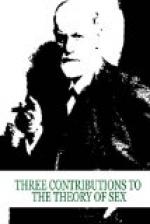If the transference of the erogenous excitability from the clitoris to the vagina has succeeded, the woman has thus changed her leading zone for the future sexual activity; the man on the other hand retains his from childhood. The main determinants for the woman’s preference for the neuroses, especially for hysteria, lie in this change of the leading zone as well as in the repression of puberty. These determinants are therefore most intimately connected with the nature of femininity.
THE OBJECT-FINDING
While the primacy of the genital zones is being established through the processes of puberty, and the erected penis in the man imperiously points towards the new sexual aim, i.e., towards the penetration of a cavity which excites the genital zone, the object-finding, for which also preparations have been made since early childhood, becomes consummated on the psychic side. While the very incipient sexual gratifications are still connected with the taking of nourishment, the sexual impulse has a sexual object outside its own body in his mother’s breast. This object it loses later, perhaps at the very time when it becomes possible for the child to form a general picture of the person to whom the organ granting him the gratification belongs. The sexual impulse later regularly becomes autoerotic, and only after overcoming the latency period is there a resumption of the original relation. It is not without good reason that the suckling of the child at its mother’s breast has become a model for every amour. The object-finding is really a re-finding.[5]
The Sexual Object of the Nursing Period.—However, even after the separation of the sexual activity from the taking of nourishment, there still remains from this first and most important of all sexual relations an important share, which prepares the object selection and assists in reestablishing the lost happiness. Throughout the latency period the child learns to love other persons who assist it in its helplessness and gratify its wants; all this follows the model and is a continuation of the child’s infantile relations to his wet nurse. One may perhaps hesitate to identify the tender feelings and esteem of the child for his foster-parents with sexual love; I believe, however, that a more thorough psychological investigation will establish this identity beyond any doubt. The intercourse between the child and its foster-parents is for the former an inexhaustible source of sexual excitation and gratification of erogenous zones, especially since the parents—or as a rule the mother—supplies the child with feelings which originate from her own sexual life; she pats it, kisses it, and rocks it, plainly taking it as a substitute for a full-valued sexual object.[6] The mother would probably be terrified if it were explained to her that all her tenderness awakens the sexual impulse of her child and prepares




